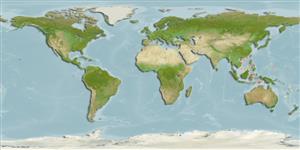Klassifizierung / Names
Namen | Synonyme | Catalog of Fishes(Gattung, Arten) | ITIS | CoL | WoRMS | Cloffa
Elasmobranchii (Haie und Rochen) (sharks and rays) >
Carcharhiniformes (Ground sharks) >
Scyliorhinidae (Cat sharks) > Scyliorhininae
Etymology: Cephaloscyllium: cephalus, from kephale (Gr.), head, referring to its very broad and depressed head; skylion, Greek for dogfish or small shark. (See ETYFish); cooki: In honor of the late Sidney F. Cook (1953-1997), shark fisheries biologist, “whose energy, dedication and contribution to shark conservation is sadly missed”. (See ETYFish).
More on authors: Last, Séret & White.
Environment: milieu / climate zone / depth range / distribution range
Ökologie
seewasser benthopelagisch; tiefenbereich 223 - 300 m (Ref. 76946). Tropical
Western Pacific: Australia and Indonesia.
Size / Gewicht / Alter
Maturity: Lm ? range ? - ? cm
Max length : 29.5 cm TL Männchen/unbestimmt; (Ref. 76946)
Kurzbeschreibung
Morphologie | Morphometrie
This small species has the following set of characters: relatively robust body, head height 10.5-14.2% TL, trunk width 17.1-21.7% TL; origin of first dorsal-fin over the centre or posterior half of pelvic-fin base; prenarial 4.9-5.5% TL in length; preorbital snout length 1.3-1.6 times the prenarial length, 2.5-3.1 in prepectoral length, 5.5-6.6 in prepelvic length; snout-vent length is short, 45.4-49.3% TL; wide nostrils, the width 3.0-3.4% TL; eye-spiracle space wide, 1.0-1.2% TL; small pectoral fin, height 9.4-10.2% TL, posterior margin 8.9-9.8% TL; anal fin low 2.8-3.4% TL; caudal peduncle long, anal-caudal space 6.3-6.9% TL; teeth mainly with 3 cusps near symphysis of upper jaw; mainly weakly tricuspidate are the flank denticles; back without greatly enlarged denticles; very long adult clasper, its outer length to at least 10% TL, almost reaching anal fin, interspace 0.9-1.0% TL; vertebral centra 101-106; tooth count low, 48-62 teeth in each jaw; 8 dark, white-edged saddles on the upper half of body, tail and caudal fin; under-surface mainly uniform greyish, with the snout darkest (Ref. 76946).
Life cycle and mating behavior
Geschlechtsreife | Fortpflanzung | Ablaichen | Eier | Fecundity | Larven
Last, P.R., B. Séret and W.T. White, 2008. New swellsharks (Cephaloscyllium: Scyliorhinidae) from the Indo-Australian region. In Last, P.R., White, W.T. & Pogonoski, J.J. (eds.): Descriptions of New Australian Chondrichthyans. CSIRO Marine and Atmospheric Research Paper no. 22. (Ref. 76946)
IUCN Rote Liste Status (Ref. 130435)
Bedrohung für Menschen
Harmless
Nutzung durch Menschen
Mehr Information
NamenSynonymeMetabolismusRäuberÖkotoxikologieFortpflanzungGeschlechtsreifeAblaichenSpawning aggregationFecundityEierEientwicklung
Alter/GrößeWachstumLänge-GewichtLänge-LängeLängenhäufigkeitenMorphometrieMorphologieLarvenLarven Pop.Dyn.RekrutierungDichteBRUVS
ReferenzenAquakulturAquakultur ProfilZuchtlinienGenetikElectrophoresesVererbbarkeitKrankheitenVerarbeitungNutrientsMass conversion
PartnerBilderStamps, Coins Misc.LauteCiguateraGeschwindigkeitSchwimmstilKiemenoberflächeOtolithsGehirngrößeSehfähigkeit
Tools
Zusatzinformationen
Download XML
Internet Quellen
Estimates based on models
Preferred temperature (Ref.
123201): 8.4 - 13.9, mean 13 °C (based on 28 cells).
Phylogenetic diversity index (Ref.
82804): PD
50 = 0.5000 [Uniqueness, from 0.5 = low to 2.0 = high].
Bayesian length-weight: a=0.00263 (0.00139 - 0.00497), b=3.21 (3.04 - 3.38), in cm total length, based on LWR estimates for this (Sub)family-body shape (Ref.
93245).
Trophic level (Ref.
69278): 3.8 ±0.5 se; based on size and trophs of closest relatives
Widerstandsfähigkeit (Ref.
120179): niedrig, Verdopplung der Population dauert 4,5 - 14 Jahre. (Preliminary low fecundity).
Fishing Vulnerability (Ref.
59153): Low vulnerability (20 of 100).
